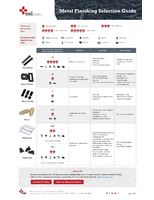Wire Rope Fittings eliminate need for swage press.
Press Release Summary:

Made of materials such as stainless steel, Electroline non-swage wire rope fitting facilitates onsite installation without chemistry, heat, pressure, or special tooling. Wire rope passes through sleeve, strands are fanned-out, and plug is inserted. As plug is driven into fanned end of rope, end diameter increases so that rope cannot dislodge itself. Inspection hole reveals rope strands so that proper assembly may be confirmed.
Original Press Release:
Latest Wire Rope Fittings Facilitate Installation in the Field - Without a Swage Press
Aesthetically pleasing fittings are strong, reliable, user-friendly and even reusable "Woven" from strands of carbon steel, wire rope is the primary medium currently available for transmitting physical tension over long stretches of space. It is widely used in applications ranging from mining to the military. Wire rope is also ubiquitous in the world of construction, outdoor recreation and seafaring. With it, a tower crane can lift a multi-ton steel girder to the top of a high-rise in progress. Ski lifts carry winter sports enthusiasts to the snowy slopes via wire rope. And it is with wire rope that ships too large to moor with conventional or synthetic rope remain at dock. In the 1930s, German engineers developed swage pressing, a method for terminating wire rope and providing an attachment to which it can be secured. Swage- pressing is accomplished with a multi-step process. The rope end is looped and the loop covered by an aluminum sleeve. The sleeve is then subjected via a press to a pressure level sufficient to cause the rope and the aluminum to merge, resulting in an unbreakable bond. Swage pressing is effective but not inexpensive, due to the equipment involved. Nor are the presses easy to manage. They're big, bulky, power-hungry, and for fieldwork can become problematic. The good news is that the marketplace now provides a practical alternative to swage- pressing. Pressing Problems As a press may run on up to 220 volts, a good-sized generator or local power source must be available for swage work in the field. Portable presses address the size issue fundamental to conventional swage pressing but for a business on a budget the cure may be worse than the disease. The price of the average portable is often astronomical, and in many cases well out of striking range of R.O.I. "A swage press can weigh between 800-1500 pounds," says John Graham, President, Riggers Services Inc., a rigging products distributor and manufacturer's representative based in Gladstone, Oregon. "The many negatives associated with the technology stem mostly from energy and bulk issues. There are portable presses out there, one model with its own gas-powered generator. But what you gain in small material and application efficiencies using some portables you lose in money overall as most are incredibly expensive." Swage fittings are not field installer-friendly. A specialized die set must be used for each size of wire rope. The dies can run up to $2,000 per set, and as many as 24 sets may be needed to cover all sizes. Moreover, a swage fitting cannot be reused because it has been literally married to the rope as a consequence of pressing. The rope must be shortened or replaced to accept a new fitting, a process as expensive in terms of time as it is in material. A Fitting Alternative Non-swage wire rope fittings accomplish all the things for which the older technology was designed, and more. Perhaps the biggest payback, however, is the fact that they do so minus the drawbacks inherent in swage pressing. No bulky, expensive equipment need be dragged to the site to get the show on the road. Through the years, non-swage wire rope fittings have evolved into first-rate technology. The fittings available today are strong, reliable, versatile, user-friendly and reusable. All are characteristics much desired in an industrial and manufacturing environment increasingly characterized by the need for speed, cost savings and greater efficiency. A leading non-swage, wire rope fitting brand, Electroline, is provided by Esmet Inc., a manufacturing company based in Canton, Ohio (www.esmet.com). According to Graham, Electroline fittings are remarkably easy to load. Onsite installation goes down without the involvement of chemistry, heat, or pressure. There's also no special tooling required, no bottom-line-eroding die sets to throw money at as in the case of swage fittings. "An Electroline wire rope fitting is installed much like a compression fitting in a plumbing application," he explains. "The wire rope passes through a sleeve. The strands are fanned-out and a plug is inserted. As the plug is driven into the fanned end of the rope, the diameter of the end increases so that the rope can't dislodge itself. The last thing you do is to put a socket over the sleeve and thread it on tight. It's a procedure essentially entailing three steps." Electroline fitting assemblies are testable as well via a seconds-long onsite inspection process. Each fitting is equipped with an inspection hole through which the rope strands are visible, and proper assembly confirmed. An Electroline fitting is also esthetically pleasing, and therefore appropriate for many applications. More importantly, however, its highly polished, well-finished appearance conveys an impression of strength and security. According to Graham this is not sizzle without steak. The fittings are machined to incredible tolerances. They look and perform like the precision instruments they actually are. Ubiquitous & Salable Electroline fittings are used in a wide variety of applications. Because they are made of high-quality materials such as stainless steel they are a niche product for outdoors use where rust can be a problem. They can be found in zoos, outdoor parking lots, public ballparks, and in just about any other outdoor venue where wire rope is employed. Stainless steel Electroline fittings are also frequently deployed as termination forks, eyes and turnbuckles on sailboat rigging. They work equally well on both wire and synthetic rope. The military, for example, uses field-installed lifeline fittings on the synthetic rope deployed on naval vessels. The fittings are much-used in commercial architecture as well. Webs of stainless steel wire rope equipped with Electroline fittings often support the open roofs on large complexes such as shopping malls. "We carry Electroline fittings specifically for customers involved with ocean research," says Ray Mayes, President, Obert Marine Inc., a distributor of industrial marine equipment based in Seattle, Washington. "Government entities researching tsunamis, tides, currents and temperature prefer them for sea-based studies because the fittings stay well lubricated, swivel under pressure and never fail. There are a multitude of possible applications for Electroline fittings, and demand is enormous. We introduced them to our customers about 20 years ago, and the fittings have been selling themselves ever since. In my opinion, Electroline is no-risk deal for distributors." For more information about Electroline fittings, contact Esmet Inc.; 1406 Fifth Street SW, Canton, Ohio 44702; (800) 321-0870 phone, (330) 452-2557 fax, www.esmet.com.




